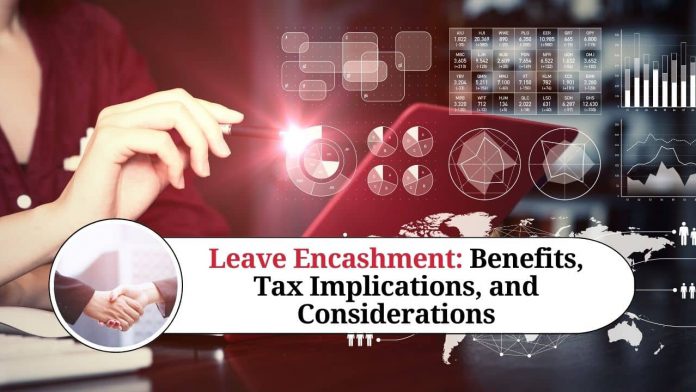Leave encashment: Understanding the concept and its benefits
Leave encashment is a process of compensating employees for the leaves they have earned but have not availed of. It allows employees to receive monetary compensation for their unutilized leave days. It is an essential part of the employment contract, and every organization has its own leave policy, which determines the number of leaves an employee is entitled to.
In this blog, we will discuss leave encashment in detail, including its benefits, tax implications, and some frequently asked questions.
What is Leave Encashment?
Leave encashment is a process in which an employee receives monetary compensation for the leave days they have not availed of during their tenure in the organization. It is an essential part of the employee’s employment contract, and the policy is decided by the organization.
Benefits of Leave Encashment
Leave encashment offers several benefits to employees, such as:
- Additional Income: It allows employees to receive additional income, which can be helpful in meeting their financial goals.
- Encourages Employees to Work: Leave encashment encourages employees to work continuously without taking excessive leaves as they can receive monetary compensation for their unutilized leave days.
- Acts as a Motivation: Employees feel motivated to work harder and perform better as they know that they will be compensated for their hard work through leave encashment.
- Facilitates Cash Flow: It provides employees with additional cash flow, which can be beneficial in emergencies.
- Helps in Employee Retention: Leave encashment can also act as a retention tool as employees are more likely to stay in an organization that offers such benefits.
Tax Implications of Leave Encashment
Leave encashment is taxable under the Income Tax Act, 1961. However, the taxability of leave encashment depends on the following factors:
- The period of earned leave credited to the employee’s account.
- The period of service completed by the employee.
- The salary of the employee.
- The tax rate applicable to the employee.
Leave encashment is a policy that is usually offered to employees as part of their employment contract. The policy specifies the number of leave days an employee is entitled to, and the conditions under which the leave can be encashed.
The leave encashment policy differs from organization to organization. Some organizations allow employees to encash all their unutilized leave days, while others have a cap on the number of leave days that can be encashed. Some organizations also have a minimum service period requirement before an employee can encash their leave days.
Leave encashment is an attractive benefit for employees, as it provides them with additional income. It also encourages employees to work continuously without taking excessive leaves. However, organizations must ensure that the policy is implemented fairly and consistently, and that employees are aware of the conditions under which leave can be encashed.
Tax implications of leave encashment are an important consideration for employees. Under the Income Tax Act, 1961, leave encashment is taxable, and the tax liability depends on various factors such as the period of earned leave credited to the employee’s account, the period of service completed by the employee, the salary of the employee, and the tax rate applicable to the employee. Employees should be aware of the tax implications of leave encashment and plan their finances accordingly.
In addition to the benefits and tax implications of leave encashment, there are a few other considerations to keep in mind.
Firstly, it’s important to ensure that the leave policy is clear and well-communicated to employees. This includes specifying the number of leave days an employee is entitled to, the conditions under which leave can be availed or encashed, and any limitations on the maximum number of leave days that can be encashed. Employees should be aware of these policies from the start of their employment, and any changes to the policy should be communicated clearly.
Another important consideration is to ensure that leave encashment is not used as a substitute for regular pay increases or other benefits. Employees should still receive regular pay raises and benefits as part of their employment contract, and leave encashment should be viewed as an additional benefit rather than a replacement for other benefits.
Finally, it’s important to ensure that the leave policy is implemented fairly and equitably across all employees. This means that all employees should be entitled to the same number of leave days and that leave encashment should be offered on the same terms to all employees. Any deviations from this policy should be clearly communicated and justified.
Conclusion
Leave encashment can be a valuable benefit for employees, providing them with additional income and helping to motivate them to work harder. However, it’s important to ensure that the policy is clear, well-communicated, and implemented fairly and equitably across all employees. By doing so, organizations can ensure that leave encashment is a positive and valuable benefit for their employees.
Read more useful content:
Frequently Asked Questions (FAQs)
Q1.) What is leave encashment?
Leave encashment is a policy that allows employees to convert their unutilized leave days into cash, which is paid out to the employee.
Q2.) Is leave encashment mandatory?
No, leave encashment is not mandatory. It is up to the organization to decide whether or not to offer leave encashment to their employees.
Q3.) Can an employee encash all their leave days?
It depends on the organization’s policy. Some organizations allow employees to encash all their leave days, while others have a cap on the maximum number of leave days that can be encashed.
Q4.) Is leave encashment taxable?
Yes, leave encashment is taxable. The tax liability depends on various factors such as the period of earned leave credited to the employee’s account, the period of service completed by the employee, the salary of the employee, and the tax rate applicable to the employee.
Q5.) How is the amount of leave encashment calculated?
The amount of leave encashment is calculated based on the employee’s salary and the number of leave days being encashed. The exact formula may vary depending on the organization’s policy.
Q6.) Can an employee encash their sick leave?
It depends on the organization’s policy. Some organizations allow employees to encash their sick leave, while others do not.
Q7.) Can an employee encash their earned leave if they resign?
It depends on the organization’s policy. Some organizations allow employees to encash their earned leave if they resign, while others do not.
Q8.) Can an employee encash their leave days if they are terminated?
It depends on the organization’s policy. Some organizations allow employees to encash their leave days if they are terminated, while others do not.
Q9.) Can an employee carry forward their leave days to the next year?
It depends on the organization’s policy. Some organizations allow employees to carry forward their leave days to the next year, while others have a “use it or lose it” policy.
Q10.) Can an employee donate their leave days to a colleague?
It depends on the organization’s policy. Some organizations allow employees to donate their leave days to a colleague who is facing a medical emergency or other unforeseen circumstances, while others do not.




















